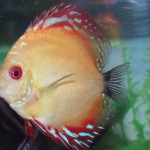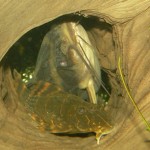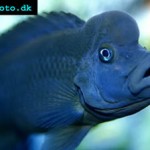In aquariums your main concern in lighting is meeting the needs of the plants and invertebrates in the tank. Some plants or corals, clams and anemones desire large amounts of light for an extensive photo-period (length of time there is light). Others are not so fussy but there are some important points you need to remember.
Firstly a normal fluorescent desk lamp will not really work. This is because it doesn’t give out the right type of light. In the same way a rainbow has 7 colours, daylight also has a spectrum of light. This means that it will have certain amounts of light in different frequencies or colours out of the rainbow (as we aren’t being too technical).
This daylight can be called full spectrum and this is the kind of light you will wanting to be replicating. Normal everyday use fluorescent tubes just don’t have the right frequencies of light and are no where near the right intensity or strength.
In a tank with no plants and no corals just some good intense florescent lights as normal tubes or power compacts will do the trick. Make sure that they are VHO or very high output lights with full spectrum coverage to keep your fish happy.
In a planted fresh water aquarium you need to have some fluorescent lights that cover the full spectrum of light. The full spectrum tubes will also normalize the visible colour in your aquarium so it is nice to look at and not some strange colour.
In addition to this you will wish to add tubes which give off specific frequencies of light that plants really like to use in order to grow.
Plants manufacture sugars from light during photosynthesis so I you boost the correct type of light the plants will grow better.
Some freshwater tanks that are very deep or with large quantities or very light demanding plants may use metal halide lamps but that is more the realm of marine tanks and corals. What is important is to provide your tank with the right amount and type of light.
Aquarium lighting in marine tanks is a little different. As I mentioned before; if you only have fish VHO full spectrum fluorescent lights or power compact lights will be fine. If you have any invertebrates you will need some actinic lighting which provides the correct types of blue light found in oceans that invertebrates use. This actinic light is usually provided by fluorescent lights as tubes or power compacts.
If you want to keep invertebrates like anemones, clams and corals that demand large quantities of light you will need metal halide lighting. You will want one light for each 2-3 feet of aquarium. You will also need these lights if your aquariums are deeper than 40 cm. These lights give off massive amounts of light and get very hot so never look at them directly.
You will need the correct type of globes which will be available at your local fish shop or over the internet. They can range between 75 watts and 450 watts. They also need to provide the right kind of spectrum so don’t be tempted into buying cheaper mercury vapour lights as they are too yellow and do not give a proper spectrum.
An important thing is that sunlight itself is actually not so good for your aquarium.
Algae will be encouraged through the large quantity of light available and you will end up having to do a lot of cleaning and it really won’t promote plant growth. Direct sunlight will also warm your tank up and in a small tank this can be very bad.
The reason that corals need such strong light is they actually photosynthesize or rather the algae that lives inside the coral’s cells photosynthesizes and provides the coral with energy. This is also true of clams and anemones. This means that without the very strong light that you would find around the equator where corals mainly grow they do not live in an unlit tank very well.
Lighting is possibly one of the more important aspects to get right in terms of keeping corals along with water quality because the wrong level of light, either too bright or too dull, will end up in an unhappy and then very dead coral.
So do your research to try to find out what kind of light your invertebrates need. See if you can get the species name of the corals you buy and have a look at what type of light they require. This will help a lot in even just placing them properly in the tank.
So in conclusion get some good strong and full spectrum lighting and check out what kind of lighting your plants and invertebrates need this will save many headaches down the track.
















